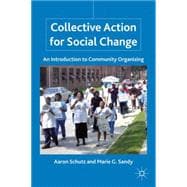
What is included with this book?
PART I: OVERVIEW * What is Community Organizing? * What isn’t Community Organizing? * PART II: HISTORY AND THEORY * The History of Community Organizing in America * Saul Alinsky’s Model of Organizing * Campaign versus Community Organizing: Storytelling in Obama’s 2008 Presidential Campaign * PART III: CASE STUDIES * The Industrial Areas Foundation and “Organizations of Organizations” (by Mark Warren) * ACORN and “Door Knocking” Groups (by Heidi Swarts) * An Independent Organizing Group * PART IV: KEY CONCEPTS * Overview: Core Organizing Concepts * Public vs. Private Relationships * Leadership * Power * One-on-One Interviews * Issues * Tactics or “Actions” * Strategy * Conclusion: Limitations of the Neo-Alinsky Organizing Model
The New copy of this book will include any supplemental materials advertised. Please check the title of the book to determine if it should include any access cards, study guides, lab manuals, CDs, etc.
The Used, Rental and eBook copies of this book are not guaranteed to include any supplemental materials. Typically, only the book itself is included. This is true even if the title states it includes any access cards, study guides, lab manuals, CDs, etc.